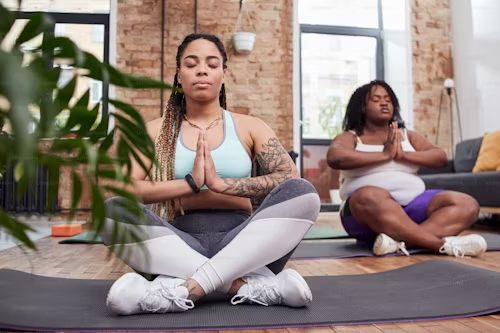
Mental Health for Parkinson’s: Mindfulness and Meditation
By Grisell Gonzalez, B.A., C-IAYT, E-RYT500
Participate in our bilingual online class designed to help manage Parkinson's symptoms. This class addresses key issues such as anxiety, depression, trauma or PTSD related to falling fears, and cognitive challenges. It is tailored for both newly diagnosed individuals and those with progressive Parkinson’s Disease. Through mindfulness, meditation, cognitive exercises, and guided auditory techniques, you’ll gain valuable tools to improve your well-being and alleviate chronic pain.
Yoga Therapy and Its Evolution
Yoga therapy, with roots in ancient traditions, has seamlessly blended with modern medical practices over the centuries. It’s a holistic approach that integrates physical postures, breath work (pranayama), and mindfulness meditation to foster overall health. For individuals with Parkinson’s Disease, yoga therapy provides a gentle and supportive method to manage symptoms and enhance quality of life. This practice has evolved to meet contemporary needs, making it an invaluable resource in today’s wellness landscape.
How Yoga Helps with Parkinson’s Disease
Yoga therapy offers a comprehensive approach to managing Parkinson's Disease, addressing both physical and mental health aspects. For those with Parkinson’s, practicing yoga can alleviate common symptoms such as stiffness, tremors, and balance issues. Regular engagement in yoga can lead to significant improvements in mobility, flexibility, and overall relaxation.
Mental health benefits are equally crucial. Research indicates that yoga can effectively reduce anxiety and depression, which are prevalent among individuals with Parkinson's. The integration of mindfulness and meditation within a yoga therapy regimen offers profound mental health benefits. Mindfulness practices help cultivate a deeper awareness of the present moment, reducing the impact of stress and negative thought patterns. This awareness can lead to a more balanced emotional state and enhanced overall mental resilience.
Meditation complements this by fostering emotional stability and a greater sense of control. It provides tools for managing chronic pain and navigating the psychological challenges associated with Parkinson’s Disease. Techniques such as focused breathing and guided imagery help to calm the mind, diminish feelings of anxiety, and improve mood.
Practical Tips
Here are some accessible techniques to integrate mindfulness and meditation into your daily life:
- Chair Twist with Mindful Breathing
○ Instructions:
■ Sit comfortably on a chair with your feet flat on the floor and your back straight.
■ Place your right hand on the back of the chair and gently twist your torso to the right, holding the back of the chair for support.
■ As you hold the twist, find a focal point and gaze softly there. Take a deeper breath: inhale slowly through your nose, feeling your ribcage expand, and exhale gently to release any tension. Keep your attention on the sensations in your body.
■ Hold the stretch for 5 breaths.
■ Slowly return to the starting position and repeat on the left side.
○ Benefits: This exercise combines a gentle spinal twist with mindful breathing, helping to improve spinal mobility and reduce stiffness. The mindful breathing aspect enhances relaxation, reduces stress, and promotes mental clarity, which is particularly beneficial for individuals managing Parkinson’s Disease.
- Bhramari (Bee Breath)
○ Instructions:
■ Sit comfortably with your back straight and shoulders relaxed. Rest your hands on your knees.
■ Close your eyes gently and take a slow breath in through your nose.
■ Exhale while making a soft humming sound in your throat, similar to the sound of a bee (the term "Bhramari" means "bee" in
Sanskrit). Feel the vibration in your head and face.
■ Continue to hum gently and steadily for the duration of your exhale.
■ Inhale deeply again through your nose and repeat the humming on your exhale.
■ Practice for 1-3 minutes, focusing on the calming sound and vibrations.
○ Benefits: Bhramari helps calm the nervous system, reduce stress, and improve concentration. For individuals with Parkinson’s Disease, this technique can aid in relaxation, alleviate anxiety, and enhance mental clarity by engaging the parasympathetic nervous system and promoting a sense of calm.
Personal Insight
With over eight years of experience teaching yoga therapy for Parkinson’s Disease, I’ve found profound joy in supporting individuals with Parkinson’s and their caregivers. This work is especially meaningful to me because I’ve witnessed the significant impact that regular practice can have on people’s lives. One memorable experience involved a student named Maria, who, through our sessions, gained confidence in her movements and felt more empowered over her body. Her progress is a testament to the powerful effects of mindful movement and inspires me to continue offering compassionate and effective support to those managing Parkinson’s Disease.
Incorporating mindfulness and meditation into a yoga therapy protocol provides essential support for enhancing the lives of those with Parkinson’s Disease. These practices help manage symptoms, boost emotional resilience, and cultivate a deeper sense of well-being. Whether you're newly diagnosed or have been managing Parkinson’s for years, these techniques can have a profound impact. Join our bilingual classes to discover how these transformative methods can lead to new avenues of health and vitality.
Works Cited:
- Sah, Ajit, and Michael Boucher. "Breathing Techniques for Pain and Anxiety Management: A Review of the Literature." Journal of Pain & Palliative Care Pharmacotherapy, vol. 26, no. 3, 2012, pp. 272-279. PubMed Central, https://www.ncbi.nlm.nih.gov/pmc/articles/PMC3447533/.
- Wynne, Diana. "Pranayama: Breathing Techniques for Health and Well-Being." Yoga Journal, 22 Oct. 2021, https://www.yogajournal.com/practice/energetics/pranayama/.

